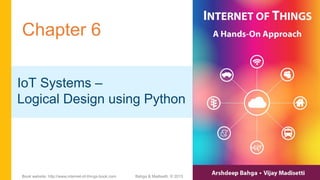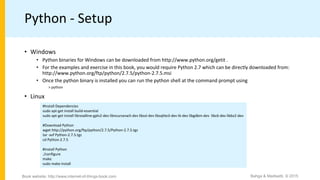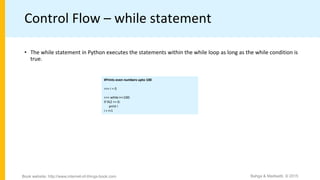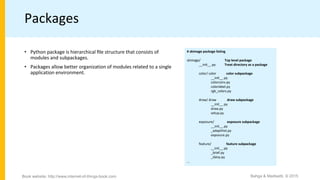This document summarizes key concepts about the Python programming language covered in Chapter 6 of the book "IoT Systems – Logical Design using Python". It discusses Python's characteristics as a multi-paradigm, interpreted, and interactive language. It also covers Python data types including numbers, strings, lists, tuples and dictionaries. Additionally, it demonstrates Python control flow using if statements and provides examples of type conversions. The document aims to introduce readers to Python concepts through examples for designing IoT systems using the programming language.






![Strings
• Strings
• A string is simply a list of characters in order. There are no limits to the number of characters you can have in a string.
#Create string
>>>s="Hello World!"
>>>type(s)
<type ’str’>
#String concatenation
>>>t="This is sample program."
>>>r = s+t
>>>r
’Hello World!This is sample program.’
#Get length of string
>>>len(s)
12
#Convert string to integer
>>>x="100"
>>>type(s)
<type ’str’>
>>>y=int(x)
>>>y
100
#Print string
>>>print s
Hello World!
#Formatting output
>>>print "The string (The string (Hello World!)
has 12 characters
#Convert to upper/lower case
>>>s.upper()
’HELLO WORLD!’
>>>s.lower()
’hello world!’
#Accessing sub-strings
>>>s[0]
’H’
>>>s[6:]
’World!’
>>>s[6:-1]
’World’
#strip: Returns a copy of the string with the
#leading and trailing characters removed.
>>>s.strip("!")
’Hello World’
Bahga & Madisetti, © 2015Book website: http://www.internet-of-things-book.com](https://image.slidesharecdn.com/chapter-6-181121123835/85/Chapter-6-7-320.jpg)
![Lists
• Lists
• List a compound data type used to group together other values. List items need not all have the same type. A list contains items
separated by commas and enclosed within square brackets.
#Create List
>>>fruits=[’apple’,’orange’,’banana’,’mango’]
>>>type(fruits)
<type ’list’>
#Get Length of List
>>>len(fruits)
4
#Access List Elements
>>>fruits[1]
’orange’
>>>fruits[1:3]
[’orange’, ’banana’]
>>>fruits[1:]
[’orange’, ’banana’, ’mango’]
#Appending an item to a list
>>>fruits.append(’pear’)
>>>fruits
[’apple’, ’orange’, ’banana’, ’mango’, ’pear’]
#Removing an item from a list
>>>fruits.remove(’mango’)
>>>fruits
[’apple’, ’orange’, ’banana’, ’pear’]
#Inserting an item to a list
>>>fruits.insert(1,’mango’)
>>>fruits
[’apple’, ’mango’, ’orange’, ’banana’, ’pear’]
#Combining lists
>>>vegetables=[’potato’,’carrot’,’onion’,’beans’,’r
adish’]
>>>vegetables
[’potato’, ’carrot’, ’onion’, ’beans’, ’radish’]
>>>eatables=fruits+vegetables
>>>eatables
[’appl
e’,
’mang
o’,
’orang
e’,
’banan
a’,
’pear’, ’potato’, ’carrot’, ’onion’, ’beans’, ’radish’]
#Mixed data types in a list
>>>mixed=[’data’,5,100.1,8287398L]
>>>type(mixed)
<type ’list’>
>>>type(mixed[0])
<type ’str’>
>>>type(mixed[1])
<type ’int’>
>>>type(mixed[2])
<type ’float’>
>>>type(mixed[3])
<type ’long’>
#Change individual elements of a list
>>>mixed[0]=mixed[0]+" items"
>>>mixed[1]=mixed[1]+1
>>>mixed[2]=mixed[2]+0.05
>>>mixed
[’data items’, 6, 100.14999999999999, 8287398L]
#Lists can be nested
>>>nested=[fruits,vegetables]
>>>nested
[[’apple’, ’mango’, ’orange’, ’banana’, ’pear’],
[’potato’, ’carrot’, ’onion’, ’beans’, ’radish’]]
Bahga & Madisetti, © 2015Book website: http://www.internet-of-things-book.com](https://image.slidesharecdn.com/chapter-6-181121123835/85/Chapter-6-8-320.jpg)
![Tuples
• Tuples
• A tuple is a sequence data type that is similar to the list. A tuple consists of a number of values separated by commas and enclosed
within parentheses. Unlike lists, the elements of tuples cannot be changed, so tuples can be thought of as read-only lists.
#Create a Tuple
>>>fruits=("apple","mango","banana","pineapple")
>>>fruits
(’apple’, ’mango’, ’banana’, ’pineapple’)
>>>type(fruits)
<type ’tuple’>
#Get length of tuple
>>>len(fruits)
4
#Get an element from a tuple
>>>fruits[0]
’apple’
>>>fruits[:2]
(’apple’, ’mango’)
#Combining tuples
>>>vegetables=(’potato’,’carrot’,’onion’,’radish’)
>>>eatables=fruits+vegetables
>>>eatables
(’apple’, ’mango’, ’banana’, ’pineapple’, ’potato’, ’carrot’, ’onion’, ’radish’)
Bahga & Madisetti, © 2015Book website: http://www.internet-of-things-book.com](https://image.slidesharecdn.com/chapter-6-181121123835/85/Chapter-6-9-320.jpg)
![Dictionaries
• Dictionaries
• Dictionary is a mapping data type or a kind of hash table that maps keys to values. Keys in a dictionary can be of any data type, though
numbers and strings are commonly used for keys. Values in a dictionary can be any data type or object.
#Create a dictionary
>>>student={’name’:’Mary’,’id’:’8776’,’major’:’CS’}
>>>student
{’major’: ’CS’, ’name’: ’Mary’, ’id’: ’8776’}
>>>type(student)
<type ’dict’>
#Get length of a dictionary
>>>len(student)
3
#Get the value of a key in dictionary
>>>student[’name’]
’Mary’
#Get all items in a dictionary
>>>student.items()
[(’gender’, ’female’), (’major’, ’CS’), (’name’, ’Mary’),
(’id’, ’8776’)]
#Get all keys in a dictionary
>>>student.keys()
[’gender’, ’major’, ’name’, ’id’]
#Get all values in a dictionary
>>>student.values()
[’female’, ’CS’, ’Mary’, ’8776’]
#Add new key-value pair
>>>student[’gender’]=’female’
>>>student
{’gende
r’: ’female’, ’major’: ’CS’, ’name’: ’Mary’, ’id’: ’8776’}
#A value in a dictionary can be another dictionary
>>>student1={’name’:’David’,’id’:’9876’,’major’:’ECE’}
>>>students={’1’: student,’2’:student1}
>>>students
{’1’:
{’gende
r’: ’female’, ’major’: ’CS’, ’name’: ’Mary’, ’id’: ’8776’}, ’2’:
{’
major’: ’ECE’, ’name’: ’David’, ’id’: ’9876’}}
#Check if dictionary has a key
>>>student.has_key(’name’)
True
>>>student.has_key(’grade’)
False
Bahga & Madisetti, © 2015Book website: http://www.internet-of-things-book.com](https://image.slidesharecdn.com/chapter-6-181121123835/85/Chapter-6-10-320.jpg)
![Type Conversions
#Convert to string
>>>a=10000
>>>str(a)
’10000’
#Convert to int
>>>b="2013"
>>>int(b)
2013
#Convert to float
>>>float(b)
2013.0
#Convert to long
>>>long(b)
2013L
#Convert to list
>>>s="aeiou"
>>>list(s)
[’a’, ’e’, ’i’, ’o’, ’u’]
#Convert to set
>>>x=[’mango’,’apple’,’banana’,’mango’,’banana’]
>>>set(x)
set([’mango’, ’apple’, ’banana’])
• Type conversion examples
Bahga & Madisetti, © 2015Book website: http://www.internet-of-things-book.com](https://image.slidesharecdn.com/chapter-6-181121123835/85/Chapter-6-11-320.jpg)
![Control Flow – if statement
• The if statement in Python is similar to the if statement in other languages.
>>>a = 25**5
>>>if a>10000:
print "More"
else:
print "Less"
More
>>>s="Hello World"
>>>if "World" in s:
s=s+"!"
print s
Hello World!
>>>if a>10000:
if a<1000000:
print "Between 10k and 100k"
else:
print "More than 100k"
elif a==10000:
print "Equal to 10k"
else:
print "Less than 10k"
More than 100k
>>>student={’name’:’Mary’,’id’:’8776’}
>>>if not student.has_key(’major’):
student[’major’]=’CS’
>>>student
{’major’: ’CS’, ’name’: ’Mary’, ’id’: ’8776’}
Bahga & Madisetti, © 2015Book website: http://www.internet-of-things-book.com](https://image.slidesharecdn.com/chapter-6-181121123835/85/Chapter-6-12-320.jpg)
![Control Flow – for statement
• The for statement in Python iterates over items of any sequence (list, string, etc.) in the order in which they
appear in the sequence.
• This behavior is different from the for statement in other languages such as C in which an initialization,
incrementing and stopping criteria are provided.
#Looping over characters in a string
helloString = "Hello World"
for c in helloString:
print c
#Looping over keys in a dictionary
student
=
’nam
e’:
’Mar
y’, ’id’: ’8776’,’gender’: ’female’, ’major’: ’CS’
for key in student:
print "%s: %s" % (key,student[key]
#Looping over items in a list
fruits=[’apple’,’orange’,’banana’,’mango’]
i=0
for item in fruits:
print "Fruit-%d: %s" % (i,item)
i=i+1
Bahga & Madisetti, © 2015Book website: http://www.internet-of-things-book.com](https://image.slidesharecdn.com/chapter-6-181121123835/85/Chapter-6-13-320.jpg)

![Control Flow – range statement
• The range statement in Python generates a list of numbers in arithmetic progression.
#Generate a list of numbers from 10 - 100 with increments
of 10
>>>range(10,110,10)
[10, 20, 30, 40, 50, 60, 70, 80, 90,100]
#Generate a list of numbers from 0 – 9
>>>range (10)
[0, 1, 2, 3, 4, 5, 6, 7, 8, 9]
Bahga & Madisetti, © 2015Book website: http://www.internet-of-things-book.com](https://image.slidesharecdn.com/chapter-6-181121123835/85/Chapter-6-15-320.jpg)
![Control Flow – break/continue statements
• The break and continue statements in Python are similar to the statements in C.
• Break
• Break statement breaks out of the for/while loop
• Continue
• Continue statement continues with the next iteration.
#Continue statement example
>>>fruits=[’apple’,’orange’,’banana’,’mango’]
>>>for item in fruits:
if item == "banana":
continue
else:
print item
apple
orange
mango
#Break statement example
>>>y=1
>>>for x in range(4,256,4):
y = y * x
if y > 512:
break
print y
4
32
384
Bahga & Madisetti, © 2015Book website: http://www.internet-of-things-book.com](https://image.slidesharecdn.com/chapter-6-181121123835/85/Chapter-6-16-320.jpg)
![Control Flow – pass statement
• The pass statement in Python is a null operation.
• The pass statement is used when a statement is required syntactically but you do not want any command or
code to execute.
>fruits=[’apple’,’orange’,’banana’,’mango’]
>for item in fruits:
if item == "banana":
pass
else:
print item
apple
orange
mango
Bahga & Madisetti, © 2015Book website: http://www.internet-of-things-book.com](https://image.slidesharecdn.com/chapter-6-181121123835/85/Chapter-6-17-320.jpg)
![Functions
• A function is a block of code that takes information in (in the form of
parameters), does some computation, and returns a new piece of
information based on the parameter information.
• A function in Python is a block of code that begins with the keyword
def followed by the function name and parentheses. The function
parameters are enclosed within the parenthesis.
• The code block within a function begins after a colon that comes after
the parenthesis enclosing the parameters.
• The first statement of the function body can optionally be a
documentation string or docstring.
students = { '1': {'name': 'Bob', 'grade': 2.5},
'2': {'name': 'Mary', 'grade': 3.5},
'3': {'name': 'David', 'grade': 4.2},
'4': {'name': 'John', 'grade': 4.1},
'5': {'name': 'Alex', 'grade': 3.8}}
def averageGrade(students):
“This function computes the average grade”
sum = 0.0
for key in students:
sum = sum + students[key]['grade']
average = sum/len(students)
return average
avg = averageGrade(students)
print "The average garde is: %0.2f" % (avg)
Bahga & Madisetti, © 2015Book website: http://www.internet-of-things-book.com](https://image.slidesharecdn.com/chapter-6-181121123835/85/Chapter-6-18-320.jpg)
![Functions - Default Arguments
• Functions can have default values of the parameters.
• If a function with default values is called with fewer parameters or without any parameter, the default values of the
parameters are used
>>>def displayFruits(fruits=[’apple’,’orange’]):
print "There are %d fruits in the list" % (len(fruits))
for item in fruits:
print item
#Using default arguments
>>>displayFruits()
apple
orange
>>>fruits = [’banana’, ’pear’, ’mango’]
>>>displayFruits(fruits)
banana
pear
mango
Bahga & Madisetti, © 2015Book website: http://www.internet-of-things-book.com](https://image.slidesharecdn.com/chapter-6-181121123835/85/Chapter-6-19-320.jpg)
![Functions - Passing by Reference
• All parameters in the Python functions are passed by reference.
• If a parameter is changed within a function the change also reflected back in the calling function.
>>>def displayFruits(fruits):
print "There are %d fruits in the list" % (len(fruits))
for item in fruits:
print item
print "Adding one more fruit"
fruits.append('mango')
>>>fruits = ['banana', 'pear', 'apple']
>>>displayFruits(fruits)
There are 3 fruits in the list
banana
pear
apple
#Adding one more fruit
>>>print "There are %d fruits in the list" % (len(fruits))
There are 4 fruits in the list
Bahga & Madisetti, © 2015Book website: http://www.internet-of-things-book.com](https://image.slidesharecdn.com/chapter-6-181121123835/85/Chapter-6-20-320.jpg)
![Functions - Keyword Arguments
• Functions can also be called using keyword arguments that identifies the arguments by the parameter name when the
function is called.
>>>def
printStudentRecords(name,age=20,major=’CS’):
print "Name: " + name
print "Age: " + str(age)
print "Major: " + major
#This will give error as name is required argument
>>>printStudentRecords()
Traceback (most recent call last):
File "<stdin>", line 1, in <module>
TypeError: printStudentRecords() takes at least 1
argument (0 given)
#name is a formal argument.
#**kwargs is a keyword argument that receives all
arguments except the formal argument as a
dictionary.
>>>def student(name, **kwargs):
print "Student Name: " + name
for key in kwargs:
print key + ’: ’ + kwargs[key]
>>>student(name=’Bob’, age=’20’, major = ’CS’)
Student Name: Bob
age: 20
major: CS
#Correct use
>>>printStudentRecords(name=’Alex’)
Name: Alex
Age: 20
Major: CS
>>>printStudentRecords(name=’Bob’,age=22,major=’EC
E’)
Name: Bob
Age: 22
Major: ECE
>>>printStudentRecords(name=’Alan’,major=’ECE’)
Name: Alan
Age: 20
Major: ECE
Bahga & Madisetti, © 2015Book website: http://www.internet-of-things-book.com](https://image.slidesharecdn.com/chapter-6-181121123835/85/Chapter-6-21-320.jpg)

![Modules
• Python allows organizing the program
code into different modules which
improves the code readability and
management.
• A module is a Python file that defines
some functionality in the form of functions
or classes.
• Modules can be imported using the import
keyword.
• Modules to be imported must be present
in the search path.
#student module - saved as student.py
def averageGrade(students):
sum = 0.0
for key in students:
sum = sum + students[key]['grade']
average = sum/len(students)
return average
def printRecords(students):
print "There are %d students" %(len(students))
i=1
for key in students:
print "Student-%d: " % (i)
print "Name: " + students[key]['name']
print "Grade: " + str(students[key]['grade'])
i = i+1
#Using student module
>>>import student
>>>students = '1': 'name': 'Bob', 'grade': 2.5,
'2': 'name': 'Mary', 'grade': 3.5,
'3': 'name': 'David', 'grade': 4.2,
'4': 'name': 'John', 'grade': 4.1,
'5': 'name': 'Alex', 'grade': 3.8
>>>student.printRecords(students)
There are 5 students
Student-1:
Name: Bob
Grade: 2.5
Student-2:
Name: David
Grade: 4.2
Student-3:
Name: Mary
Grade: 3.5
Student-4:
Name: Alex
Grade: 3.8
Student-5:
Name: John
Grade: 4.1
>>>avg = student. averageGrade(students)
>>>print "The average garde is: %0.2f" % (avg)
3.62
# Importing a specific function from a module
>>>from student import averageGrade
# Listing all names defines in a module
>>>dir(student)
Bahga & Madisetti, © 2015Book website: http://www.internet-of-things-book.com](https://image.slidesharecdn.com/chapter-6-181121123835/85/Chapter-6-23-320.jpg)





![Class Example
• The variable studentCount is a
class variable that is shared by
all instances of the class
Student and is accessed by
Student.studentCount.
• The variables name, id and
grades are instance variables
which are specific to each
instance of the class.
• There is a special method by
the name __init__() which is
the class constructor.
• The class constructor
initializes a new instance
when it is created. The
function __del__() is the class
destructor
# Examples of a class
class Student:
studentCount = 0
def __init__(self, name, id):
print "Constructor called"
self.name = name
self.id = id
Student.studentCount = Student.studentCount + 1
self.grades={}
def __del__(self):
print "Destructor called"
def getStudentCount(self):
return Student.studentCount
def addGrade(self,key,value):
self.grades[key]=value
def getGrade(self,key):
return self.grades[key]
def printGrades(self):
for key in self.grades:
print key + ": " + self.grades[key]
>>>s = Student(’Steve’,’98928’)
Constructor called
>>>s.addGrade(’Math’,’90’)
>>>s.addGrade(’Physics’,’85’)
>>>s.printGrades()
Physics: 85
Math: 90
>>>mathgrade = s.getGrade(’Math’)
>>>print mathgrade
90
>>>count = s.getStudentCount()
>>>print count
1
>>>del s
Destructor called
Bahga & Madisetti, © 2015Book website: http://www.internet-of-things-book.com](https://image.slidesharecdn.com/chapter-6-181121123835/85/Chapter-6-29-320.jpg)

